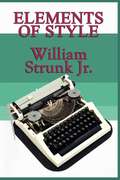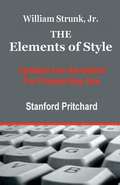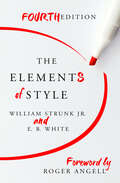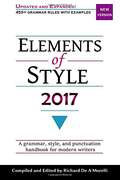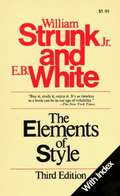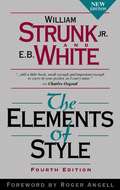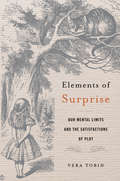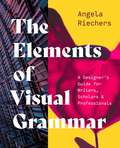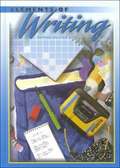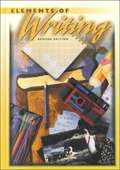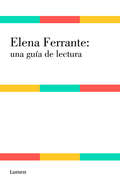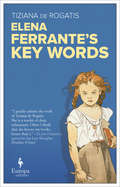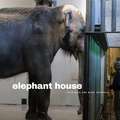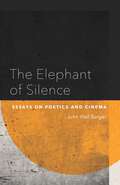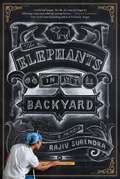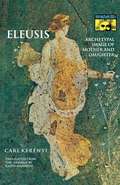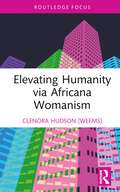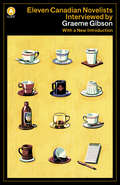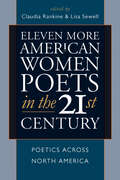- Table View
- List View
The Elements of Style: Simplified & Illustrated for Busy People
by William Strunk Jr. Virginia CampbellThe Elements of Style is widely considered America’s most beloved grammar book. Now, in this stylish 100th anniversary edition of The Elements of Style, readers of today will find a fresh, succinct new grammar book--full of everything you need to know about writing and nothing you don’t. <P><P>This new edition of The Elements of Style has been carefully modernized for the way we write and learn today. Outdated rules have been updated; important advice has been highlighted; and a clean and visually interesting design has breathed new life into this classic grammar book. And with over 100 memory cues and vintage illustrations, visual learners and the forgetful alike will never again fail to remember an important grammar or punctuation rule.
Elements of Style
by William StrunkThe Elements of Style (1918), by William Strunk, Jr., and E.B. White, is an American English writing style guide. It is the best-known, most influential prescriptive treatment of English grammar and usage, and often is required reading and usage in U.S. high school and university composition classes. This edition of The Elements of Style details eight elementary rules of usage, ten elementary principles of composition, "a few matters of form," and a list of commonly misused words and expressions.
The Elements of Style: Updated and Annotated for Present-Day Use
by William Strunk Stanford PritchardThe book was revised and expanded by E. B. White, of New Yorker fame, in 1959, but it has had no significant update since 1979. And since that time, many little affronts (for some of us, insults) to the eye and ear have gotten into the language. So here is a new edition of Strunk's classic work, with many of his rules and pronouncements expanded and explained; with new sections on proper usage and correct spelling; and even a "Rogue's Gallery" comprised of samples of egregious writing culled from current newspapers and magazines. For anyone who will reflect on it, language is an ongoing, fascinating adventure. The author intends this book to make that adventure more rewarding, and more enjoyable. Oh. The difference between "dryer" and "drier"? That, like so much else, is in the book.
The Elements of Style
by E. B. White William Strunk Jr.The fourth edition of the timeless composition guide, including an introduction by E. B. White and a foreword by Roger Angell. First published in 1919 as a primer for Cornell University students, The Elements of Style became a renowned reference for writers of all kinds. With a straightforward manner that exemplifies its own advice, this succinct book covers everything from tips on proper comma usage to the principles of effective communication. The manual also includes lists of common errors to avoid, making it an indispensable asset for anyone seeking to write clear, correct, and engaging prose. Later reissued with revisions, an introduction, and a chapter on writing by E. B. White, The Elements of Style is now in its fourth edition and features a foreword by White&’s stepson, the essayist Roger Angell.
Elements of Style 2017
by Richard De A'MorelliElements of Style 2017 presents a collection of modern grammar, style, and punctuation rules to help you write well, self-edit efficiently, and produce a grammar-perfect final draft. It is suitable for writers, editors, proofreaders, college students, and employees in the workplace. In fact, if you write anything at all, you should have a copy of this writer’s style guide on your desk. It has been recognized as a modern, go-to writing handbook and is now a required textbook in some college courses at University of San Francisco, University of Minnesota, California State University at Fullerton, and University of Texas at San Antonio, among others. <p><p> This book is a major update to Strunk’s original Elements of Style, written 100 years ago. It was inspired by Strunk's grammar classic, follows the same point-by-point format, and presents grammar and style rules in a concise, easy-to-understand manner. The book includes many of Strunk's rules from his original edition, but omits rules considered out-of-date today. Elements of Style 2017 expands Strunk's book from 38 pages to 270, and presents a collection of 500+ grammar and style rules for modern writers, editors, college students, and others who are called upon to write a grammar-perfect final draft.
The Elements of Style (3rd edition)
by E. B. White William Strunk Jr.An American classic on pithy writing and perfect grammar.
The Elements of Style (4th edition)
by E. B. White William Strunk Jr.This book's unique tone, wit and charm have conveyed the principles of English style to millions of readers. Use the fourth edition of "the little book" to make a big impact with writing.
Elements of Surprise: Our Mental Limits and the Satisfactions of Plot
by Vera TobinWhy do some surprises delight—the endings of Agatha Christie novels, films like The Sixth Sense, the flash awareness that Pip’s benefactor is not (and never was!) Miss Havisham? Writing at the intersection of cognitive science and narrative pleasure, Vera Tobin explains how our brains conspire with stories to produce those revelatory plots that define a “well-made surprise.” By tracing the prevalence of surprise endings in both literary fiction and popular literature and showing how they exploit our mental limits, Tobin upends two common beliefs. The first is cognitive science’s tendency to consider biases a form of moral weakness and failure. The second is certain critics’ presumption that surprise endings are mere shallow gimmicks. The latter is simply not true, and the former tells at best half the story. Tobin shows that building a good plot twist is a complex art that reflects a sophisticated understanding of the human mind. Reading classic, popular, and obscure literature alongside the latest research in cognitive science, Tobin argues that a good surprise works by taking advantage of our mental limits. Elements of Surprise describes how cognitive biases, mental shortcuts, and quirks of memory conspire with stories to produce wondrous illusions, and also provides a sophisticated how-to guide for writers. In Tobin’s hands, the interactions of plot and cognition reveal the interdependencies of surprise, sympathy, and sense-making. The result is a new appreciation of the pleasures of being had.
Elements of the Writing Craft: More Than 150 Lessons for Fiction and Nonfiction Writers
by Robert OlmsteadGreat narratives are built piece by piece, through myriad small tasks and careful moves. In this landmark book, Robert Olmstead shows how distinguished writers past and present have built their fiction and nonfiction. Through this writer's-eye analysis of more than 150 of literature's most finely crafted passages, you'll learn to read like a writer. Then, more than 500 innovative exercises challenge you to experiment with - and expand upon - the techniques of the masters, so you can use them for great narratives of your own.
The Elements of Visual Grammar: A Designer's Guide for Writers, Scholars, and Professionals (Skills For Scholars Ser.)
by Angela RiechersA color-illustrated introduction to the basic principles of visual language that every content creator and consumer needs to knowThe right images capture attention, pique curiosity, and inspire viewers to stick around long enough to read any accompanying text. Nearly everyone today needs to use or understand images in communications of all kinds, from the most formal professional publication to the most casual social media post, and knowing the basics of visual language is essential for content creators and consumers alike. However, most people aren’t taught visual grammar unless they go into art- or design-related fields. The Elements of Visual Grammar explains image use in any media in practical terms for writers, scholars, and other professionals. Award-winning art director and design professor Angela Riechers offers a flexible set of principles and best practices for selecting images that work—and using them in the most persuasive way. The result is an indispensable guide for anyone who wants to learn how to work more successfully with images and words.Features more than 200 color illustrations—drawn from a wide range of styles, media, and eras—that demonstrate the principles of visual grammar and how images can support and enhance written contentDefines and illustrates the basic elements of images, describes how images function within text regardless of media, and explains how to choose images and integrate them with textIntroduces the practical, cultural, conceptual, and scientific factors that influence image useAnalyzes images by function and describes ways to employ symbolism, synecdoche, allegory, metaphor, analogy, and iconography
Elements Of Writing: First Course
by KinneavyHolt Elements of Writing Student Edition Grade 7 9780030508622
Elements of Writing: Fourth Course (Revised Edition 10th Grade)
by James L. Kinneavy John E. WarrinerWriting textbook
Elements of Writing: Introductory Course (Revised Edition)
by James L. Kinneavy John E. WarrinerIntroductory textbook on writing and grammar.
Elements of Writing Third Course
by James L. Kinneavy John E. WarrinerA language arts textbook covering the following areas in three parts: PART 1 Writing PART 2 Handbook PART 3 Resources
Elena Ferrante: una guía de lectura
by Ilaria MartinelliTodo lo que necesitas saber para adentrarte en la fiebre Ferrante. Nadie sabe quién es Elena Ferrante, y sus editores de origen procuran mantener un silencio absoluto sobre su identidad. Hay quien ha llegado a sospechar que es un hombre; otros dicen que nació en Nápoles pero que ahora vive en Turín. La mayoría de críticos la saludan como la nueva Elsa Morante, una voz extraordinaria que ha dado un vuelco a la narrativa de los últimos años. Su éxito entre la crítica y el público se refleja en artículos publicados por periódicos y revistas tan notables como The New York Times y The Paris Review. En 2011, Lumen publicó un volumen titulado Crónicas del desamor, donde se reunían El amor molesto, Los días del abandono y La hija oscura, sus tres primeras novelas. Luego vino la saga compuesta por La amiga estupenda, Un mal nombre, Las deudas del cuerpo y, finalmente, La niña perdida, un cuarto volumen que cierra una obra destinada a convertirse en un clásico de la literatura europea del siglo XXI. «No me arrepiento de mi anonimato. Descubrir la personalidad de quien escribe a través de las historias que propone, de sus personajes, de los objetos y paisajes que describe, del tono de su escritura, no es ni más ni menos que un buen modo de leer.»Elena Ferrante en una entrevista por correo con Paolo di Stefano para Il Corriere della Sera
Elena Ferrante's Key Words
by Tiziana de Rogatis“Tackles novelist Elena Ferrante’s Neapolitan quartet in terms of their ‘creative forms of [female] resistance’ . . . A richly layered study.” —Kirkus Reviews“I greatly admire the work of Tiziana de Rogatis. She is a reader of deep refinement. Often I think that she knows my books better than I. So, I read her with admiration and remain silent.” —Elena Ferrante, in the magazine, San Lian Sheng Huo Zhou KanFerrante’s four-volume novel cycle known in English as the Neapolitan quartet has become a global success, with over ten million readers in close to fifty countries. Her readers recount feeling “addicted” to the novels; they describe a pleasure in reading that is as rare as it is irresistible, a compulsion that leads them either to devour the books or to ration them so as to prolong the pleasure.De Rogatis here addresses that same transnational, diverse, transversal audience. Elena Ferrante’s Key Words is conceived as a lighted path made of luminous key words that synthesize the multiform aspects of Ferrante’s writing and guide us through the labyrinth of her global success.“An exceptional companion to the source material, particularly for the lit-crit crowd looking to affirm Ferrante’s reinvention of the future of the novel.” —Library Journal
Elephant House (Animalibus: Of Animals and Cultures #7)
by Dick Blau Nigel RothfelsIn Elephant House, photographer Dick Blau and historian Nigel Rothfels offer a thought-provoking study of the Oregon Zoo’s Asian Elephant Building and the daily routines of its residents—human and pachyderm alike. Without an agenda beyond a desire to build a deeper understanding of this enigmatic environment, Elephant House is the result of the authors’ unique creative collaboration and explores the relationships between captive elephants and their human caregivers.Blau’s evocative photographs are complex and challenging, while Rothfels’s text offers a scholarly and personal response to the questions that surround elephants and captivity. Elephant House does not take sides in the debate over zoos but focuses instead on the bonds of attentiveness between the animals and their keepers. Accompanied by a foreword from retired elephant keeper Mike Keele, Elephant House is a frank, fascinating look at the evolving world of elephant husbandry.
Elephant House (Animalibus)
by Nigel RothfelsIn Elephant House, photographer Dick Blau and historian Nigel Rothfels offer a thought-provoking study of the Oregon Zoo’s Asian Elephant Building and the daily routines of its residents—human and pachyderm alike. Without an agenda beyond a desire to build a deeper understanding of this enigmatic environment, Elephant House is the result of the authors’ unique creative collaboration and explores the relationships between captive elephants and their human caregivers.Blau’s evocative photographs are complex and challenging, while Rothfels’s text offers a scholarly and personal response to the questions that surround elephants and captivity. Elephant House does not take sides in the debate over zoos but focuses instead on the bonds of attentiveness between the animals and their keepers. Accompanied by a foreword from retired elephant keeper Mike Keele, Elephant House is a frank, fascinating look at the evolving world of elephant husbandry.
The Elephant of Silence: Essays on Poetics and Cinema
by John Wall Barger“A poem is an act of faith because the poet believes in it,” contends John Wall Barger in The Elephant of Silence, a collection of essays exploring forms of knowing (and not knowing) that awaken a poetic mind. By considering poetry, film, and the intersections among aesthetic moments and our lives, Barger illuminates the foundations of poetic craft but also probes how to be alive, creative, and open in the world. Each piece investigates unanswerable questions and indefinable words: Lorca’s duende, Nabokov’s poshlost, Bashō’s underglimmer, Huizinga’s ludic, Tarkovsky’s Zona. Influenced by poets such as Glück and Ruefle, and filmmakers such as Kubrick and Lynch, Barger writes—first always sharing his own personal life stories—on the nature of perception, experience, and the human mind. With lyric eloquence and disarming candor, The Elephant of Silence tackles how to live an imaginative life, how to gravitate toward the silence from which art comes, and how the mystical is also the everyday.
The Elephants in My Backyard: A Memoir
by Rajiv SurendraRajiv Surendra was filming Mean Girls, playing the beloved rapping mathlete Kevin Gnapoor, when a cameraman insisted he read Yann Martel's Life of Pi. So begins his "lovely and human" (Jenny Lawson, author of Furiously Happy) tale of obsessively pursuing a dream, overcoming failure, and finding meaning in life."This was a once-in-a-lifetime chance. I found myself standing dangerously close to the edge of a cliff. Far below me was an incredible abyss with no end in sight. I could turn back and safely return to where I had come from, or I could throw caution to the wind, lift my arms up into the air . . . and jump." --From The Elephants in My Backyard What happens when you spend ten years obsessively pursuing a dream, and then, in the blink of an eye, you learn that you have failed, that the dream will not come true? In 2003, Rajiv Surendra was filming Mean Girls, playing the beloved rapping mathlete Kevin Gnapoor, when a cameraman insisted he read Yann Martel's Life of Pi. Mesmerized by all the similarities between Pi and himself--both are five-foot-five with coffee-colored complexions, both share a South Indian culture, both lived by a zoo--when Rajiv learns that Life of Pi will be made into a major motion picture he is convinced that playing the title role is his destiny. In a great leap of faith Rajiv embarks on a quest to embody the sixteen-year-old Tamil schoolboy. He quits university and buys a one-way ticket from Toronto to South India. He visits the sacred stone temples of Pondicherry, he travels to the frigid waters off the coast of rural Maine, and explores the cobbled streets of Munich. He befriends Yann Martel, a priest, a castaway, an eccentric old woman, and a pack of Tamil schoolboys. He learns how to swim, to spin wool, to keep bees, and to look a tiger in the eye. All the while he is really learning how to dream big, to fail, to survive, to love, and to become who he truly is. Rajiv Surendra captures the uncertainty, heartache, and joy of finding ones place in the world with sly humor and refreshing honesty. The Elephants in My Backyard is not a journey of goals and victories, but a story of process and determination. It is a spellbinding and profound book for anyone who has ever failed at something and had to find a new path through life.
The Elephants Teach: Creative Writing Since 1880
by David Gershom MyersWhen Vladimir Nabokov was up for a chair in literature at Harvard, the linguist Roman Jakobson protested: “What’s next? Shall we appoint elephants to teach zoology?” That anecdote, with which D. G. Myers begins The Elephants Teach, perfectly frames the issues this book tackles. Myers explores more than a century of debate over how writing should be taught and whether it can or should be taught in a classroom at all. Along the way, he incorporates insights from a host of poets and teachers, including Henry Wadsworth Longfellow, Ralph Waldo Emerson, Robert Frost, John Berryman, John Dewey, Lionel Trilling, Robert Lowell, Ezra Pound, and Saul Bellow. And from his exhaustive research, Myers extracts relevant background information on nineteenth-century educational theory; shifts in technology, publishing, and marketing; the growth of critical theory in this country; and the politics of higher education. While he shows how creative writing has become a machine for creating more creative writing programs, Myers also suggests that its history supplies a precedent for something different—a way for creativity and criticism, poetry and scholarship, to join together to produce not just writing programs but good writers. Updated with fresh commentary on what’s happened to creative writing in the academy since the first edition was published ten years ago, The Elephants Teach will be indispensable for students and teachers of writing, literature, and literary history.
Eleusis: Archetypal Image of Mother and Daughter (Bollingen Series (General) #634)
by Carl KerényiThe Sanctuary of Eleusis, near Athens, was the center of a religious cult that endured for nearly two thousand years and whose initiates came from all parts of the civilized world. Looking at the tendency to "see visions," C. Kerenyi examines the Mysteries of Eleusis from the standpoint not only of Greek myth but also of human nature. Kerenyi holds that the yearly autumnal "mysteries" were based on the ancient myth of Demeter's search for her ravished daughter Persephone--a search that he equates not only with woman's quest for completion but also with every person's pursuit of identity. As he explores what the content of the mysteries may have been for those who experienced them, he draws on the study of archaeology, objects of art, and religious history, and suggests rich parallels from other mythologies.
Elevating Humanity via Africana Womanism (Routledge Focus on Literature)
by Clenora Hudson (Weems)Elevating Humanity via Africana Womanism is a short, but powerful book, advocating synergy via unity/collectivity as a panacea for all societal ills. It discusses the Africana Womanism theory - an authentic family centered concept for all women of African descent - as a grid upon which to erect the private and public personae of all positive Africana people. Within the context of our cultural and historical matrix, it opens with defining the paradigm, while promoting the importance of prioritizing race, class and gender, the triple plight of Black women. A workable strategy for ensuring equality for all, it closes on a note of love and spirituality, while embracing the special connection between Africana men and women, the 2-sided human coin.This introduction logically and convincingly speaks truth to power about who we, Black women are, beginning, in Part One, with naming and defining ourselves, with the foreknowledge of the seminal role of our male counterparts. It identifies the 18 descriptors of the true Africana woman and her male counterpart. Part Two offers fruitful commentary, via sharing some of the many contributions we have given to society, which could enhance self-esteem among our people, many of whom have come to not love themselves and even their own, due to inadequate historical documentation.
Eleven Canadian Novelists Interviewed by Graeme Gibson: From Eleven Canadian Novelists Interviewed By Graeme Gibson (A List)
by Graeme GibsonOriginally published in 1970, Eleven Canadian Novelists Interviewed by Graeme Gibson is a collection of candid and wide-ranging interviews with Canadian writers, including Alice Munro, Mordecai Richler, Margaret Laurence, and more.With the intuition of an insider, Gibson asks the important questions: In what way is writing important to you? Do writers know something special? Does he or she have any responsibility to society? The result is a fascinating and immensely readable series of conversations with famed writers at the beginning of their careers.The A List edition will feature a new introduction by Graeme Gibson and interviews with the following authors:Margaret AtwoodAustin ClarkeMatt CohenMarian EngelTimothy FindleyDave GodfreyMargaret LaurenceJack LudwigAlice MunroMordecai RichlerScott Symons
Eleven More American Women Poets in the 21st Century: Poetics across North America (American Poets in the 21st Century)
by Lisa Sewell Claudia RankineEleven More American Women Poets in the 21st Century is an exciting sequel to its predecessors in the American Poets in the 21st Century series. Like the earlier anthologies, this volume includes generous selections of poetry by some of the best poets of our time as well as illuminating poetics statements and incisive essays on their work. This unique organization makes these books invaluable teaching tools. Broadening the lens through which we look at contemporary poetry, this new volume extends its geographical net by including Caribbean and Canadian poets. Representing three generations of women writers, among the insightful pieces included in this volume are essays by Karla Kelsey on Mary Jo Bang's modes of artifice, Christine Hume on Carla Harryman's kinds of listening, Dawn Lundy Martin on M. NourbeSe Phillip (for whom "english / is a foreign anguish"), and Sina Queyras on Lisa Robertson's confoundingly beautiful surfaces. A companion web site will present audio of each poet's work.

